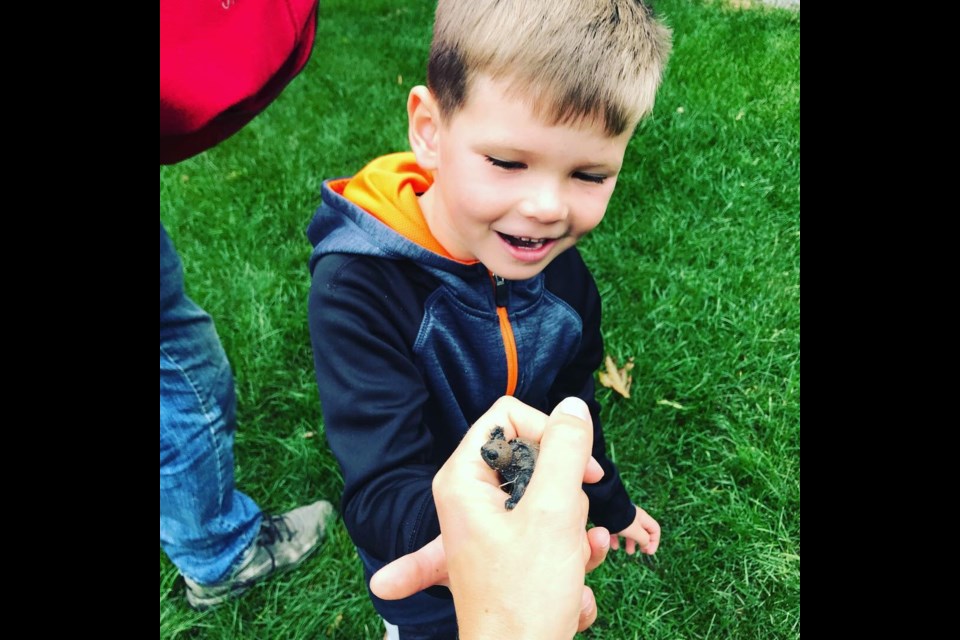In the pre-dawn calm of a warm June morning, a large, aged female snapping turtle left the safety of Lake Simcoe at Shannon Bay and trudged her way up the sloping shoreline towards the dark homes nestled on the north side of Heyden Avenue.
As the sun rose over Victoria Point, the ancient turtle found an ideal location to lay her eggs – a well-drained, sandy area that would, each day, be warmed by the afternoon sun.
In this perfect place, she dug a hole, burrowing deep into the sandy terrain and began to lay her eggs.
But this was not a perfect place for the Preston family, who had been, for months, completing extensive renovations on their lakeside home.
They were preparing for the landscaper to come when Matt Preston spied the turtle on the morning of June 11. He and his neighbour, Ray Hayhurst, watched the turtle that morning, rapt by the reptilian rascal digging in the dirt between their homes.
Soon, Matt’s wife, Saralynn, and their young boys, Owen and Quinn, got in on the action as they watched this spectacle of nature unfold steps from their front porch.
“She was a big mama and we actually watched and we could see the eggs falling; they looked like ping-pong balls,” said Saralynn, who noted the kids were amazed by what they witnessed.
“As the eggs dropped, she would bury them with her foot. She would put layers of dirt between them … it was amazing to watch the process,” she said.
After the old turtle had grunted and excavated and finished, she climbed out of the hole, tired, and “flopped on the ground” for a few minutes, said Hayhurst. “She was exhausted.”
Then, she turned her back on her offspring and began her march back to the water, where she would wait, for up to two months, for the eggs to hatch.
But because of where the nest was – in the middle of a yard about to be excavated and landscaped – the nest had to be moved. So, Hayhurst called his friend and fellow Champlain Seniors Club member Bob Bowles, a local naturalist.
“The moving of the nest was a big operation,” said Bowles, who enlisted the help of the young lads for the painstaking process of moving the eggs over to Hayhurst’s lawn.
Slowly and carefully, Bowles dug in the dirt to find each egg, which he patiently marked and then moved, in layers, so he could put them in their new home “in the exact order and depth as I found them.”
To his surprise, the nest contained 50 eggs. “When I first saw the picture of the turtle, I thought it was pretty old and that it might lay 35-40 eggs,” said Bowles.
He said a female turtle will start to lay eggs when she reaches the age of 16 or so. An older turtle typically lays 35-40 eggs. “To lay 50 eggs is pretty rare. I’m guessing the turtle is about 80 years old.”
While it’s unusual to lay that many eggs, it’s even more unusual that all 50 survived.
Over the August long weekend, the turtles began to hatch – much to the wide-eyed excitement of Owen and Quinn, who kept an eye on their new friends. At times, they helped the mud-encrusted babies make their 150-foot journey to the lake.
In the end, all 50 eggs hatched, but four young turtles did not emerge from the nest.
“They looked dead; they were caked with mud,” said Bowles. “We set them in the sun, washed them off and, after a little while, they came alive and started to head to the water.”
But two of them were lethargic, barely moving. So, Bowles asked Owen and Quinn to be guardians of the turtles overnight, to nurse them to health. Saralyn and the boys placed the turtles in a fishbowl and kept watch.
“We named them Freddy and Eddie,” said Owen, with a big smile, noting the tiny turtles loved their watery home.
That night, when the boys were asleep, Saralyn moved the fishbowl into the dark sanctuary of the pantry. “My cat is a bit notorious for eating fish from the fishbowl,” she said. “I didn’t want anything to happen to these little guys.”
By the next morning, the turtles had found their strength and, with the boys’ help, were released into the lake. “One of them did a head-dive into the water,” said Owen.
Seeing the kids’ faces and smiles brings a smile to Bowles’ face. “I think they got quite an education this summer,” he said.
But it’s bigger than that, said Bowles. Snapping turtles are an endangered species because their habitat is disappearing.
“In this case, she was fortunate because she came out of the water and found a place to nest without having to cross a busy road,” said Bowles, who noted turtles will return to the same nesting site year after year. He said it’s not unusual for a turtle to live longer than 100 years.
Saralynn was thankful for Bowles’ help. “We probably would have ruined things if we had tried to move them,” she said.
She was also thankful for her neighbour’s willingness to harbour the babies. She said Hayhurst erected a cage – borrowed from Bowles – over the new nest to protect against predators and several times during the summer, unscrewed the cage to pull weeds and ensure the eggs were able to receive the sun they craved.
“It’s pretty neat to see the way everyone pitched in and made sure these turtles would be protected,” said Bowles.
